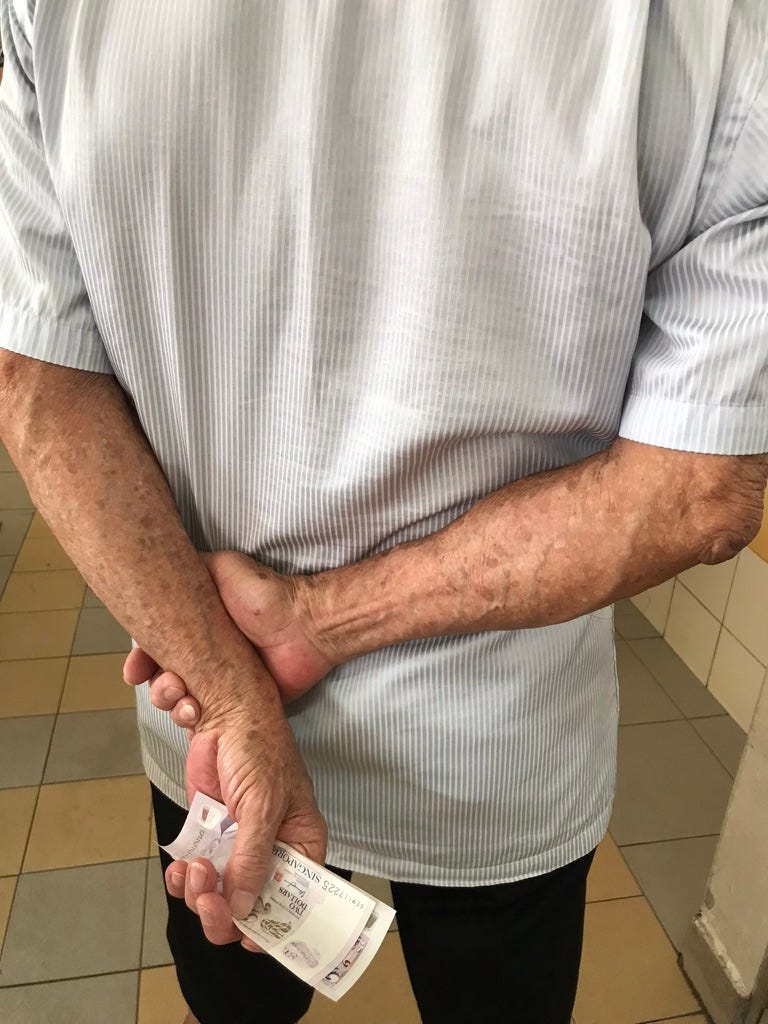Posted by TW Lim
https://letthemeatcake.substack.com/p/no-107-a-roof-on-posts
The first char kway teow I really remember came from my primary school canteen. Smoky and dark, with a single egg and three tiny cubes of rendered fatback in each plate. The egg was always speckled black: the wok had a crust, and hawker auntie was enthusiastic with her scraper. The char made it declarative, ambitious, the lardons made it feel like a sin. The wok hei wasn’t as pure as Hill Street’s, the noodles were maybe cooked a little drier, the memory of that char kway teow has stayed with me for thirty years. It’s rare to hear Singaporeans agree about hawker food, but my classmates all swear it was the best char kway teow they’ve ever had. I ate it nearly every day of primary school, because it was so good I almost never wanted to eat anything else. It’s nice to have an audience of 8 year olds.
If this doesn’t sound like a school canteen, you’re probably not from Southeast Asia (Substack tells me less than 1 in 10 of you are).
I discovered the school cafeterias of the west when I started university. To me, it looked like prison food, catering as violence, wilting food attacking from steam tables. Schools in Singapore had canteens – hawker centers in miniature. This seemed an altogether more sensible and humane arrangement. It’s a genius bit of socialization. You learn Singapore’s priorities – cheap food, orderly queues, the habit of clearing your own table. And of course, because the food was coming from actual hawker stalls, it was actually good. We might not have been much for freedom of speech or thought, but we believed in the freedom to choose your own damn lunch.
I’m thinking about all this because the government of Singapore just announced that a number of schools will have their canteens replaced with cafeterias run by central kitchens. In other words, we’ll be serving primary school students army food. The Ministry of Education asserts that this change is necessary because canteen operators are basically hawkers, and not enough of them can be found.
Since this is Singapore, and everything has to be shellacked with technology, students will order their food through an app, and pick it up from machines or lockers. Spokesfolks bemoan the long wait times at canteens, the schools with shuttered stalls, the sheer inefficiency of it all. “Principal Chen Ziyang told CNA that the model has “significantly reduced” wait times compared to traditional canteen queues,” – I can picture his little shudder of delight. Meanwhile, “existing stallholders may be referred to other schools or recommended to central kitchen operators for employment.” Singapore is short of cooks.
The canteen I grew up with was inefficient. It was in fact a little rough, even by the standards of the 1980s. The hawker centres were shiny and new then, government-built and government-approved temples to hygiene, with running water and electricity in every stall. My canteen was a roof on posts. I don’t think the stalls had plumbing. They certainly didn’t have refrigeration. Facilities for both were shared, in a large, tiled room that doubled as the drinks stall. The stalls were basically street carts without wheels, the hawkers set propane burners on collapsible stands. On weekends, they pushed everything together and wrapped it in tarp, and inverted their stools on top. This could’ve been anywhere people sold food on the street, but this was Singapore the orderly.
The auntie frying the char kway teow seemed just as unruly. Her wok had a blast radius, marked by noodles and soy sauce. You could see the miasma around her from across the canteen and smell it from across the yard. Her fluency, to my 8 year old eyes, bordered on magic. She cracked eggs with one hand, chattering with her neighbors and the line of schoolboys in front of her. If I came to think that the work of cooking is worth something, she had something to do with it. I never learned her name.
School canteens might offer the only affordable F&B rents in Singapore – a stall runs between 5 and 15 Singapore dollars a month. The problem is, there’s also something of a cap on revenue. Prices are effectively set in consultation with the school – you have to list menu prices when you apply for the stall. Your catchment is limited: outsiders generally aren’t allowed on school grounds, and schools operate only 5 days a week, 40 weeks of the year. If the administration prioritizes affordability for the students, they can quickly and unintentionally squeeze operators’ earnings to unsustainable levels.
Everyone is clearly in a bind. The rents are already nominal, and schools are obviously not about to change access rules or hours. It’s hard to see how to balance the books except via some form of subsidy or income guarantee for canteen operators – but the Singaporean government has long been reluctant to institute anything that remotely resembles a handout. The solution looks inarguably superior on paper – economies of scale! Technology! Centrally planned nutrition! The only sacrifices are intangible.
It’s not that Singaporean school canteens are a culinary paradise. The char kway teow auntie, I think, was a bit of an outlier. But at the very least, canteens reflected the distribution of hawker quality, and therefore, the quality of food in Singapore. For two years of middle school, I ate the exact same canteen meal every day, and even then, I knew it was mostly crap. Char siu from a factory, a deep fried something from another factory, and an exemplary wok-fried egg. But I chose it, it was a moment of agency and bliss, and I remember the sensation of pressing $1.40 into the auntie’s hand, and the weight of the plate she placed in mine.
Even leaving the UNESCO thing and tourism aside, hawker culture really is Singaporean culture. There’s a reason we tell hawker stories over and over – the generation who started the stall around independence, the generation who took over when Singapore was still figuring modernity out, the generation who get out and sometimes return. Hawkers remain the everyfolk every politician in every country claims to serve – even if there are fewer of them each year.
So maybe it’s apt that now opportunities that used to be offered to individual Singaporeans are being offered to large corporations instead. Being Singaporean, it seems, means prioritizing efficiency and corporate profits over some of the basic habits that make life in Singapore what it is. It means learning to form relationships with companies, screens, and lockers, rather than people you can look in the eye. Let that be a lesson in how to be Singaporean.
Related: I Dream of Canteens
Also related: A review of the food central kitchens in Singapore provide, from these pages
https://letthemeatcake.substack.com/p/no-107-a-roof-on-posts
![[Image Id: Text reads: “ #story I'm so sorry for what I'm about to do but #percy shelley” End ID]](https://64.media.tumblr.com/12247a7ef4dd0607adc485c0f8186160/203cbc8a1c29a739-b3/s640x960/d0fb3e362e90c18c3488681a9f7751cd04a36214.jpg)















